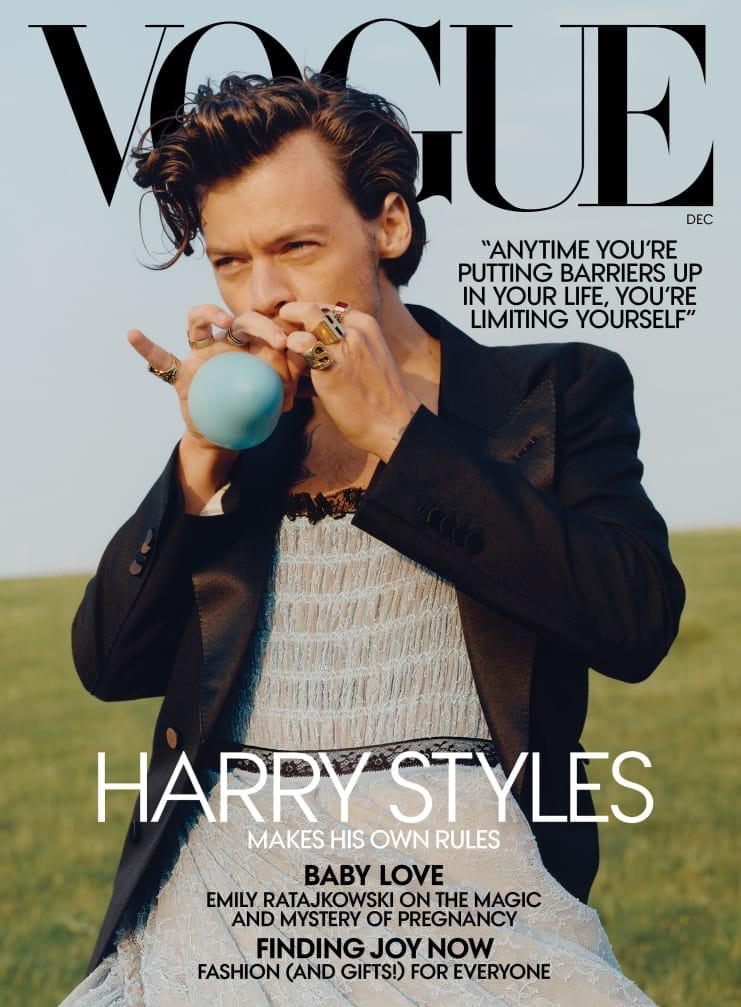The Problem with Harry Styles’ Non-Conforming Aesthetic

By Maliha Shoaib, BA English and World Philosophies
When Harry Styles’ December Vogue cover was revealed on 13 November, all hell broke loose. Every corner of the digital sphere suited up for the latest internet war over the ostensible crisis in masculinity.
Harry Styles is the first man to appear solo on the cover of American Vogue – and in a Gucci gown, no less. Unsurprisingly, the right wing was in bits. Candace Owens, an infamous pro-Trump Black female activist, criticised Styles on Twitter, saying that ‘there is no society that can survive without strong men’ and that we should ‘bring back the manly men.’ Good old Ben Shapiro followed suit as he complained that the category of masculinity is being feminised. Across the board, right-wing criticism hunkered down on the idea that men should be manly, and women should be womanly.
Numerous celebrities and fans rushed to the One Direction singer’s defence, praising him on social media as a revolutionary – a complete visionary when it comes to gender neutral representation and kicking toxic masculinity to the curb. Clearly, it is a historic moment for Vogue, potentially the most prestigious fashion magazine in the world, to feature a man in a dress. It highlights the shift in male fashion norms – the desired openness of the modern age.
These days, the essence of masculine and feminine energy is being debated more than ever: from YouTube channels on how to harness your feminine goddess energy, to debates about the role of a provider and the death of masculine stoicism. Gender roles are constantly being renegotiated in today’s landscape, and the shift in gender expression has followed suit. The world of high fashion has prided itself in pushing the limits of gender boundaries. Androgyny is in. But what are the political implications of this fashion trend, and who benefits from it?
At the core of this debate lies the question of whether aesthetic expression is intrinsic to gender identity. In other words, can a guy be simultaneously ‘feminised’ on the outside, and masculine on the inside? It would be wrong to suggest that clothes don’t play a part in how we perceive gender and how we feel about our own gender – otherwise trans folks and other non-conforming folks wouldn’t feel gender dysphoria in certain clothing. Fashion can be used to tell a story about who we are. For some people, it is essential to an expression of identity and status. But for others, fashion is just a game that can be played, and the rules are increasingly blurred.
Harry Styles seemingly belongs to the latter group. Styles told Vogue, ‘I like playing dress-up in general.’ For this attractive, white, rich, cisgender man, playing around with gender boundaries is a fun experiment. While women’s departments have always had more options for clothing – brighter colours, more prints, more variation in cut – it is clear that Styles’ statement reeks of privilege.
Although Styles is generally seen as an ally to the LGBTQ+ community, his own sexuality is unknown, but his blasé attitude fails to hit the mark. He misses the opportunity to say anything particularly meaningful about the implications and influences of his clothing choices. While the concept of freedom within fashion is alluring, fashion is not and has never been without political implications.
Non-conforming aesthetics carry a trendy status in the fashion world, but this status is not retained when non-binary and trans people engage in similar fashion choices. Ideally, fluid dressing would be just as fun for everyone else as it is for the rich and famous, but we all know that this is not the case. It’s not all fun and games for the LGBTQ+ community, particularly trans and non-binary people of colour, who continue to face harassment and stigmatisations for engaging in similar aesthetics.
‘Harry Styles can’t be crowned a gender-bending icon if he hasn’t actually addressed the concerns of the communities on the frontline of the so-called fashion revolution.’
Styles’ fluidity here is not the real problem, nor is the platform Vogue has provided him with: the real problem is the assertion that Styles is the trailblazer of this cultural shift. Harry Styles can’t be crowned a gender-bending icon if he hasn’t actually addressed the concerns of the communities on the frontline of the so-called fashion revolution.
Without addressing the concerns of the LGBTQ+ community, gender nonconformity in mainstream fashion will continue to be nothing more than a profitable trend. When we speak about this topic, it is essential to be aware of whose experience is being represented, and whose is being erased.
Regardless of its problems, one thing is for sure: Harry Styles’ Vogue cover is bringing mainstream attention to a critical conversation. And isn’t that what art is all about?
Photo Caption: Harry Styles is the December cover star for Vogue (Credit: Tyler Mitchell/Vogue).



